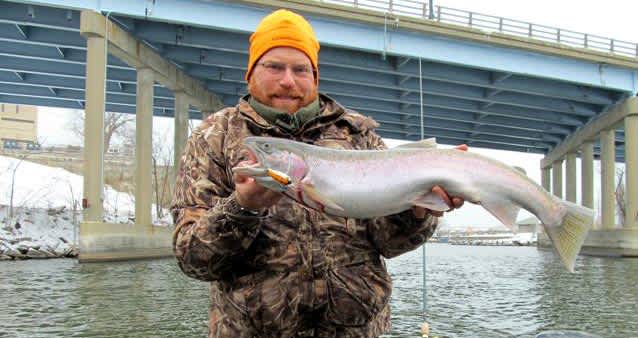The Down-low on Trolling Upstream in a Michigan Winter
Dave Mull 11.30.12

Trolling Michigan’s tributaries for winter steelhead and brown trout has always been something of a backwards proposition–most anglers try to “drop back” those plugs into a nearly dormant steelhead’s face and let it wiggle there until the fish gets fed up enough to attack.
But growing numbers of steelheaders across the Great Lakes State are learning that trolling upstream against the current is often more productive than the rainbow seekers’ version of “backtrolling.”
Apparently steelhead don’t need as much sustained wiggling in front of their faces before whacking a plug as we thought they did. In this article we’ll discuss the options on lures and tackle, speed, boat control and how to spread out your trolling swath with planer boards.
“Lots of times we face slow current in the winter,” says “Coho” Bob Lausman, who plies the St. Joseph River in the southwest corner of the state out of his vintage 18-foot Starcraft. The boat was specifically upgraded for winter river fishing with an RV-type enclosure, anchor with electric winch and super-reinforced keel to withstand beaching on rocky river banks. He also has a Minn Kota iPilot trolling motor, that spends summers on his fishing partner Elmer Rudlaff ‘s Lund. It works great as an autopilot in the river, keeping the boat on course while the four-stroke 50-horse Mercury quietly pushes the boat forward.
Lausman says when the current is too slow for backtrolling—the lures don’t kick enough—it’s usually perfect for slowly working upstream. And, areas with slow current are good places for steelhead to hold.
Gear
Rods and reels used for downriggers on the big lake feature good, forgiving bends that helps control and land a hooked fish in the river, too. Lines directly behind each corner of the boat can be on 7-foot, medium-action rods—even shorter rods are fine. Two rods set perpendicularly to the gunnel and the waters surface—straight out to the side—can be 8 to 10 feet long, which keeps those lures spread away from the lures set on the corners. Lausman almost always sets a rod with an online planer board out to each side of the boat. These rods go in holders forward of the rods sticking straight out. If he’s fishing when or where boat traffic is minimal, he sets as many as three planer board rods to each side. These rods are also bendy, medium-action sticks of the sort used for downriggers and can be 7 to 9 feet long.
For reels, baitcasters that hold enough line to handle a long run from a ticked-off steelhead are the rule. Reels with line-counters can help duplicate a set-up that just caught a fish, but usually aren’t necessary.
Lausman spools his river reels with 30- to 50-pound braided line, which is highly durable, yet super thin so lots can fit on the reels. He ties a small barrel swivel on the end of the braided line and adds a 6-foot leader of 12-pound test Blood Run Fluorocarbon.
For planer boards, Lausman likes the small. TX-6 Church Boards, which hold steady on the braided line. He likes to set these boards so they don’t release and slide towards the fish, and usually wraps the line once around the lower lip of the board’s clip.
Lures
Although his boat is loaded with different lures, Lausman puts four in particular at the top of the list for cold-water steel. A key consideration is that the lure dive within a foot of the bottom in 6- to 8-foot depths, with varying amounts of line out. Top lures include:
- Bandit C-100. Mostly known as a bass lure, this rattler features good hooks and a shallow dive, letting it be put a good ways behind the boat.
- Lindy River Rocker. A reincarnation of the old Heddon Tadpolly with brighter colors and a slightly different body shape, this lure doesn’t rattle and works especially well in super cold water when it wiggles at super slow speeds.
- Storm Rattle Tot. High action and lots of sound even in slow motion. Sometimes these go just 25 feet behind a planer board to rouse fish in shallow water to the side of the boat.
- Worden’s Mag Lip 3.5. An evolution of the banana bait with high action and lots of different, good, flashy colors.
For colors, experimentation on any given day helps, but go-to hues for Lausman include pearl with chartreuse in clearer water; metallic finishes with red lips (aka “pirates”) with silver and blue or gold and black bodies particular faves, and orange finishes whenever the water has some stain.
For more information on Michigan fishing go to michigan.org.

